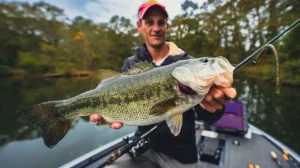Slop lakes!
You’ve seen them before – those moss-rimmed waters with snotty algae and layers of vegetation that seems never to end.
They look so fishy, yet so hard to fish – or even navigate!
And they can be. But oh, how rewarding they can be as well!
The mighty jungle
Last evening, my angling buddy Ken introduced me to one of these jungle waters.
Moss atop shallow vegetation extended 25 or more yards out around most of this roughly 60-acre lake. Cattails rimmed stretches of uninhabited wetland shoreline. Several extended soft-bottom flats were loaded with a mix of “junk weed.” Curly-leaf cabbage grew abundantly in areas just off the moss mats.
We had only several hours to fish and lost almost half our time to boat adjustments.
But we had seen enough during our boat struggles to pull together a game plan and “short-list” of baits and techniques for the abbreviated outing.
Upon our return to the water, 3- to 5-pound bass came over the gunwale.
Scouting the water
Cracking the code to these watery jungles takes forethought, patience, and preparation.
First off, don’t get frustrated. Don’t beat your brain with the difficulties of working or navigating through the thick stuff.
Pay close attention to the details of these waters. Use your depth finder in open zones to see how much deep water and hard bottom are available to the fish. But be warned: electronics may be of minimal value for most of your scouting.
Your best tools are your eyes and a boat paddle.
What’s the vegetation like? Where is the hard bottom? Where are the transition areas from one type of vegetation or bottom content to another?
Take what they give you
You’ve heard the sports cliché: “Take what the defense gives you!”
That’s an important part of this “jungle warfare.”
In some ways, decision-making on these challenging waters can be quite simple, provided you are a versatile angler – or willing to become one! Stay with baits and techniques that the habitat permits you to work effectively.
Frogs – Moss is the boss! Few categories of baits work on the “green blanket,” but there’s one that shines: the hollow-bellied frog! If you haven’t learned to fish one yet, the jungle offers opportunity! Poppin’ frogs offer another option on the edge of the moss and mats. You can also buzz the edges with swimming frogs (a.k.a. “toads,” or “buzz frogs”).
Buzzbaits – Work the edges of the mats with buzzbaits in the same way and places you would fish the swimming frogs. These are great baits to cover water quickly and determine if fish are active.
Chuggers – Like the poppin’ frogs, these can be worked on the edges and in pockets, as well as over the tops of the deeper grass.
Wake baits – Here’s a sleeper category for you. Hold your rod tip high to keep the line out of the water at the beginning of your retrieve, and keep the lure working side-to-side at the surface so that it produces a “V” wake. Watch for bulging water and followers! This is one style of bait you will want to work all the way back to the boat!
Jigs and flipping baits – Pitch to pockets in the mats and submerged vegetation and work grass edges with jig and trailer combinations and bullet-weighted soft plastic worms and creatures.
Stick worms – Your Senko-type worms can still be deadly in the tangles. Wacky rigging may work if the holes or spread between clumps of cabbage permit, but don’t forsake the Texas rig! Use a weighted offset hook if wind becomes a factor – or for a faster “triggering” presentation.
Spinnerbait – Maneuver a high-riding spinnerbait through the clumps and over the tops of plant growth. A mix of flash and vibration will catch a bass’s attention.
Back to the jungle
So what was the key to our evening success?
The water screamed wake bait. I tied on a Jackall Cherry Zero Footer. The bait left a handsome wake with a slow but steady retrieve, and a three-pounder nailed it within several casts. Ken fished the same bait in a “boat alley” cleared by the locals, and a bass brought it down within a couple casts.
I upsized my waker to a Jackall Mikey Jr. and began working it between the tops of curly-leaf cabbage plants at the edge of a cleared beach area. The Mikey produced the best fish of the evening – a bass nudging the 5-pound mark!
Be versatile, open-minded…and prepared!
This jungle fishing isn’t as hard as it looks if you are willing to take conditions for what they are.
Open your mind; open your options. Think in terms of lures and techniques that will work in the confines of this difficult but potentially rewarding angling environment.
The jungle is a place to dust off baits you seldom use or to invest in some new lures and tackle that you never thought you would need before.
One final word: make sure your rod, reel and line will allow you to work your baits properly AND have the muscle to horse a fish out of the dense jungle! The thick stuff is no place for gossamer line and feathery rods!
Grab gear stout enough for this man-to-bass jungle combat!
Mike Pehanich is a senior writer for Bassmaster magazine and publisher of Smallwatersfishing.com.












